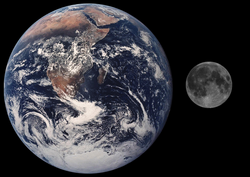Double planet

"Double planet" is an informal term used to describe a planet with a moon that may be large enough to be considered a planet in its own right; one definition requires that the objects orbit a centre of gravity that is above their surfaces. The formal term is "binary system". Similarly, there are also double asteroid (or double minor planet) systems such as 90 Antiope, and double Kuiper belt object systems such as (79360) 1997 CS29 and 1998 WW31. As of 2009, there are no official double planets. The European Space Agency has referred to the Earth-Moon system as a type of double planet.[1] The IAU General Assembly in August 2006 had a draft proposal that considered the Pluto-Charon system as a type of double planet.[2]
Definition of a double planet
There has been some debate in the past on precisely where to draw the line between a double-planet and a planet-moon system. In most cases, this is not an issue because the satellite has a small mass relative to its host planet. In particular, with the exception of the Earth-Moon and Pluto-Charon systems, all satellites in our Solar System have masses less than 0.00025 (1/4000) the mass of the host planet or dwarf planet. On the other hand, the Earth and Moon have a mass ratio of 0.01230 (≈ 1/81), and Pluto and its moon Charon have a mass ratio of 0.117 (≈ 1/9).
A commonly accepted cutoff point for deciding between a planet-satellite or double-planet system is based on the location of the center of mass of the two objects (that is, the barycenter).[citation needed] If the barycenter is not located under the surface of either body, then one may refer to the system as a double-planet system. In this case, both bodies in their entirety orbit about a point in the free space between the two. By this definition, Pluto and Charon would be seen as a "double" (dwarf) planet system, whereas the Earth and Moon might be seen as a double planet in billions of years.[3] In 2006 the International Astronomical Union briefly considered a formal definition of the term double planet which could have formally included Pluto and Charon, but this definition was not ratified. Though not accepted for official usage by the IAU, astronomer Alan Stern of the New Horizons mission to Pluto and the Kuiper belt refers to the Pluto-Charon system as a double planet.[4]
Tug-of-war definition
The late Isaac Asimov suggested a distinction between planet-moon and double-planet systems based on what he called a "tug-of-war" value.[5] This quantity is simply the ratio of the gravitational force between the planet and satellite, and the satellite and Sun. In the case of the Moon, the Sun "wins" the "tug of war," and the Earth and Moon form a double-planet system. The opposite is true for most (but not all) of the other satellite systems in our Solar System, including the Pluto-Charon system, which would be classified as planet-satellite systems.
Double Planets in fiction
- Romulus and Remus (Star Trek)
- New Washington and Franklin (Jerry Pournelle's The Prince)
- Opal and Quake (Charles Sheffield's Summertide)
- Roche and Eau (Robert L. Forward's Rocheworld)
- Urras and Anarres in Ursula K. Le Guin's The Dispossessed.)
- Genji and Chujo (Murasaki)
See also
- 2006 definition of planet
- Definition of a planet
- Hill sphere
- Natural satellite
- Orbit of the Moon
- 3753 Cruithne
References
- ^ "Welcome to the double planet". ESA. 2003-10-05. Retrieved 2009-11-12.
- ^ "The IAU draft definition of "planet" and "plutons"". International Astronomical Union. 2006-08-16. Retrieved 2008-05-17.
- ^ Robert Roy Britt (2006-08-18). "Earth's moon could become a planet". CNN Science & Space. Retrieved 2009-11-25.
- ^ http://www.oneworldblueportals.com/bernardsstar/index.php?page=blog
- ^ Asimov, Isaac (1975). Just Mooning Around, In: Of time and space, and other things. Avon.
- "Clyde Tombaugh (1906-97) Astronomer who discovered the Solar System's ninth planet", Nature 385 (1997) 778 (Pluto and Charon are "the only known example of a true double planet".)
- "It's not easy to make the Moon", Nature 389 (1997) 327 (comparing double planet theory of Moon formation and Pluto-Charon as double planet)
